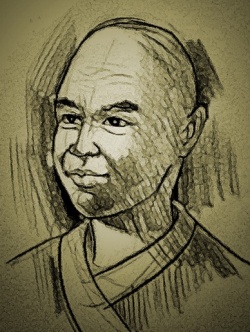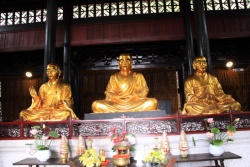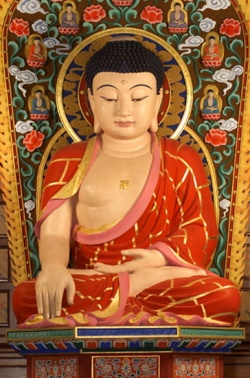Yijing (monk)
Yijing (traditional Chinese: 義淨; simplified Chinese: 义净; pinyin: Yìjìng; Wade–Giles: I Ching) (635–713 CE) was a Tang Dynasty Chinese Buddhist monk, originally named Zhang Wenming (張文明). The written records of his 25-year travels contributed to the world knowledge of the ancient kingdom of Srivijaya, as well as providing information about the other kingdoms lying on the route between China and the Nālandā Buddhist university in India. He was also responsible for the translation of a large number of Buddhist scriptures from Sanskrit into Chinese. Yijing's full Buddhist title was "Tripiṭaka Dharma Master Yijing" (三藏法師義淨).
In some 19th-century publications, Yijing's name may appear as I Tsing, following an antiquated method of Chinese romanization.
Journey
To Srivijaya and Nālandā
Zhang Wen Ming became a monk at age 14 and was an admirer of Faxian and Xuanzang, both famed monks of his childhood. Provided funding by an otherwise unknown benefactor named Fong, he decided to visit the renowned Buddhist university of Nālandā, in Bihar, India, to further study Buddhism. Traveling by a Persian boat out of Guangzhou, he arrived in Srivijaya (today's Palembang of Sumatra) after 22 days, where he spent the next six months learning Sanskrit grammar and Malay language. He went on to record visits to the nations of Malayu and Kiteh (Kedah), and in 673 after ten days additional travel reached the "naked kingdom" (south west of Shu). Yijing recorded his impression of the "Kunlun peoples", using an ancient Chinese word for Malay peoples. "Kunlun people have curly hair, dark bodies, bare feet and wear sarongs." He then arrived at the East coast of India, where he met a senior monk and stayed a year to study Sanskrit. Both later followed a group of merchants and visited 30 other principalities. Halfway to Nālandā, Yijing fell sick and was unable to walk; gradually he was left behind by the group. He was looted by bandits and stripped naked. He heard the natives would catch white skins to offer sacrifice to the gods, so he jumped into mud and used leaves to cover his lower body; he walked slowly to Nālandā where he stayed for 11 years.
Returning to Srivijaya
In the year 687, Yijing stopped in the kingdom of Srivijaya on his way back to (Tang) China. At that time Palembang was a centre of Buddhism where foreign scholars gathered, and Yijing stayed there for two years to translate original Sanskrit Buddhist scriptures into Chinese. In the year 689 he returned to Guangzhou to obtain ink and papers (note: Srivijaya then had no paper and ink) and returned again to Srivijaya the same year.
Return to China
In year 695, he completed all translation works and finally returned to Tang China at Luoyang, and received a grand welcome back by Empress Wu Zetian. His total journey took 25 years. He brought back some 400 Buddhist translated texts. Account of Buddhism sent from the South Seas and Buddhist Monk's Pilgrimage of the Tang Dynasty are two of Yijing's best travel diaries, describing his adventurous journey to Srivijaya and India, reporting on the society of India, the lifestyles of various local peoples, and more.
Distribution of Buddhist traditions
In the great majority of areas in India, Yijing writes that there were followers of both "vehicles" (Skt. yāna), with some Buddhists practicing according to the "Hīnayāna" and others practicing according to the Mahāyāna. However, he describes Northern India and most of the islands of the South Seas (i.e. Sumatra, Java, etc.) as principally "Hīnayāna." In contrast, the Buddhists in China and Malayu are described as principally following the Mahāyāna.
Yijing wrote about relationship between the various "vehicles" and the early Buddhist schools in India. He wrote, "There exist in the West numerous subdivisions of the schools which have different origins, but there are only four principal schools of continuous tradition." These schools are namely the Mahāsāṃghika Nikāya, Sthavira Nikāya, Mūlasarvāstivāda Nikāya, and Saṃmitīya Nikāya. Explaining their doctrinal affiliations, he then writes, "Which of the four schools should be grouped with the Mahāyāna or with the Hīnayāna is not determined." That is to say, there was no simple correspondence between a monastic sect and whether its members learned "Hīnayāna" or "Mahāyāna" teachings.
Buddhism in Srivijaya
Yijing praised the high level of Buddhist scholarship in Srivijaya and advised Chinese monks to study there prior to making the journey to Nālandā in India.
"In the fortified city of Bhoga, Buddhist priests number more than 1,000, whose minds are bent on learning and good practice. They investigate and study all the subjects that exist just as in India; the rules and ceremonies are not at all different. If a Chinese priest wishes to go to the West in order to hear and read the original scriptures, he had better stay here one or two years and practice the proper rules...."
Yijing's visits to Srivijaya gave him the opportunity to meet with others who had come from other neighboring islands. According to him, the Javanese kingdom of Ho-ling was due east of the city of Bhoga at a distance that could be spanned by a four or five days' journey by sea. He also wrote that Buddhism was flourishing throughout the islands of Southeast Asia. "Many of the kings and chieftains in the islands of the Southern Sea admire and believe in Buddhism, and their hearts are set on accumulating good actions."
Translations into Chinese
Yijing translated more than 60 texts into Chinese, including:
Mūlasarvāstivāda Vinaya (一切有部毗奈耶)
Suvarṇaprabhāsa Sūtra (金光明最勝王經) in 703 CE.
Vajracchedikā Prajñāpāramitā Sūtra (能斷金剛般若波羅蜜多經) (T. 239) in 703 CE.
Sūtra of the Original Vows of the Medicine Buddha of Lapis Lazuli Radiance and the Seven Past Buddhas (藥師琉璃光七佛本願功德經) (T. 451), in 707 CE.
Avadana, or Stories of Great Deeds (譬喻經) in 710 CE.


